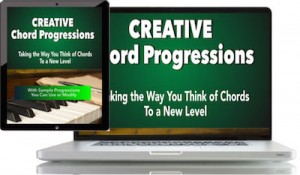How working backwards in the creation of lyrics helps to intensify anticipation.
 “The Essential Secrets of Songwriting” eBook Bundle (plus a FREE copy of “Creative Chord Progressions”) is written by Gary Ewer, designed to straighten out your technique and get you writing better songs.
“The Essential Secrets of Songwriting” eBook Bundle (plus a FREE copy of “Creative Chord Progressions”) is written by Gary Ewer, designed to straighten out your technique and get you writing better songs.
 Goal-oriented songwriting means doing a lot of working backwards as you compose. By writing in reverse direction, you do the following:
Goal-oriented songwriting means doing a lot of working backwards as you compose. By writing in reverse direction, you do the following:
- Establish a goal first, and then…
- Create the bit that leads toward the goal.
So that’s the “why” of this topic. How to do it is where you want to put some thought.
For each component of a song — lyric, chords, melody, etc — how to work backwards will be a little different. For this post, we’re going to look at an easy way to keep control of your lyrics, by working out chorus ideas first, and then looking back to what a verse might look like.
In the next two posts over the next two days, we’ll then look at how to work out chords and then melodic ideas in a backward sort of way.
Writing Lyrics Backwards
Starting with the chorus means developing the emotional response first, and then writing a sequence of words that would lead to that display of emotion.
An easy way to practice this is to start by looking through hit songs, checking out the chorus first and then moving back to look at the verse. Suggestions:
- “Here Comes the Sun” (George Harrison – The Beatles) (Chorus starts the song).
- “Somebody That I Used to Know” (Gotye) (Chorus starts at: 1’33”)
- “A Thousand Years” (Christina Perri) (Chorus starts at: 1’01”)
Looking backwards like this gives you a unique perspective on what makes lyrics work. For most listeners, a song is all about its chorus — about the emotions. By looking at the chorus first, you focus in on what makes the song connect so well. Then moving back to the verse let’s you see the verse as a generator of the emotions yet-to-come.
The more songs you analyze in this way, the more obvious it becomes that the big secret of getting song lyrics to work is to establish a framework — a story — as a first step, and then to present lyrics that tap into the emotions of the listener.
Lyrics that start with an emotional outpouring in the verse, without the listener having a chance to understand what all the drama is about, leaves nothing for the chorus to do except: more emotional outpouring!
So if you’re the kind of writer who needs to start describing emotions right away, just consider the strong likelihood that it’s the chorus you’re actually writing. Your next step is to look back: figure out what has happened to allow this emotional release, and now you’ve got a good verse-chorus combination that’s going to work for you.
______________
Written by Gary Ewer. Follow on Twitter. “The Essential Secrets of Songwriting” eBook Bundle looks at songwriting from every angle, and has been used by thousands of songwriters. How to use chords, write melodies, and craft winning lyrics. Get today’s special deal.











In general if we look at the chorus as a summary of what goes on in the verses
Especially in the Country Songs that tell a story we will be on the right track
Most of The Beatles songs that had a chorus , were very simplistic just
hammering home The Hook Chorus Ticket To Ride – From- Me To You
Hard Days Night –
Steer clear of giving new information in a chorus keep the story lines for the
Verses and Bridge
As you state here Sting is one of several successful top writers who always
works back from the Chorus or Refrain and points every verse line he writes
to the Title, which is usually The Hook